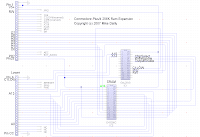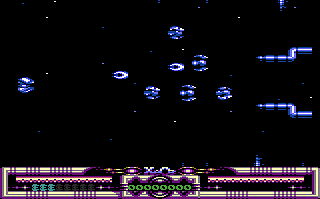


I've managed to get a proof-of-concept working; that is external RAM plugged in and working without any internal modifications at all. If I add a hardware banking register I could add up to 256 banks of 16k giving up to 4Mb RAM (although that would be a BIG stack of chips!). However, a 128,256 or 512k expansion would me much simpler. Its good to see it working, even if no one and nothing will use it!
Bearing that in mind.... I do wonder if its even worth doing any more on it as it simply wont be used! Oh well... its nice to know I was able to do it - it might be nice as a development tool though, and if I were to add an MMC card, then the extra RAM could be used as a buffer. The problem with using it as a devtool though is that the ram under it will be fried. Thats not very good, but if you were writing a program to actually USE it, then it wouldn't be a problem as you would never use the upper 32k of the machines native RAM.
Heres how I switch it on and use it....
sei
lda #$ff
sta $fdda ; Enable Upper and Lower external banks
And thats it really... The idea is that BANK 0 is always mapped to $c000-$ffff, while $8000-$bfff is user selectable via a register somewhere. And finally, heres the equations for the GAL.
/WRITE = A15* /A14* PH2* /RW ; WRITE Enable (32-48k)
/CS = /C1LOW* A15* /A14* PH2* RW ; Chip Select on READ access (32-48k)
+ A15* /A14* PH2* /RW ; On WRITE access (32-48k)
/OE = /C1LOW* A15* /A14* PH2* RW ; Output ENable on READ access (32-48k)


